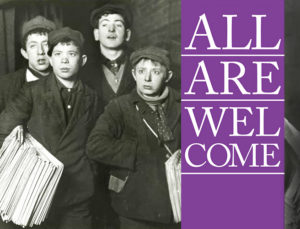All Are Welcome
In the reopening of our sanctuary this past Easter, we celebrated, and announced, “All Are Welcome” with banners and programs.
While researching Old First’s collaboration with Centennial Chapel in the 19th century, it was discovered that they too declared, “All Are Welcome” in the news.
Perhaps you have read or seen a photography exhibit of Lewis Hine’s about the newsboys, several have been mounted. From one article in the The New York Times we learn about the boys’ plight.
With the invention of the rotary press around 1847, the “penny paper” came into being. There were nearly 50 dailies in New York City by the late 1800’s requiring a vast army of newsboys to sell them. Most of these boys were homeless yet had to pay for papers out of their own pockets with no return provision for unsold papers. The boys’ existence was perilous, often sleeping huddled together in packing cases, wooden barrels and abandoned stairwells,
When the newsboys made money—some as young as 6—they were in danger of falling prey to saloonkeepers, many who catered especially to children, selling them whisky for 3 cents a glass. Needless to say, they lived lives short on nurture, food, and schooling.
The Centennial Mission History
A Mission School was started as early as 1848, providing education to the homeless newsboys. The first location was on Atlantic Avenue, moved to Smith Street at Butler, then in 1869 the school occupied a building downtown across from the courthouse. According to The Brooklyn Daily Eagle, the Centennial Mission, the subsequent iteration of this Mission School, was organized on 21 February 1869 and was housed near the corner of Adams and Fulton. This would not have been far from the St. Vincent’s Home for Boys on Boerum Place at State Street, a building which still stands today with its iconic statue of homeless boys that one can see while passing between the Brooklyn Bridge and Atlantic, heading to the Slope.
The Centennial Chapel was built in 1871 on Wyckoff near Third Avenue and the Mission moved to this location. It was an unremarkable two-story brick building with plain interior. In the obituary of a young Mrs. Martha W. Patchen, 1876, The Eagle credits her with being the founder and primary patron of the Chapel. In 1876 the Centennial Mission was serving upwards of 500 students, serviced by 40 teachers and officers, and greeted 200 worshipers in the Chapel every week. They were looking to expand.
First Reformed Church (Old First) held worship in the Centennial Chapel, and Sunday School for a time there and in homes, until our own chapel in the Carroll Street building was completed in 1888. The former Joralemon Church, and later First Reformed, supported both missions. The Centennial Chapel was listed in directories under the auspices of First Reformed during the early 1890s. First Reformed contributed nearly $2,000 in funds as late as 1891 while Dr. Farrar and the church pressed for its independence from First Reformed, to remain under the care of Rev. Stockwell. He, however, was in ill health.
Perhaps this was the beginning of the end. The Centennial Mission and Chapel’s final chapter is unclear. It was still in operation in 1896 but had suffered upheaval with departure of Rev. Stockwell and superintendent Charles C. Shelley in 1893, and many teachers and several superintendents rotated out afterwards. I have not been able to find any more information beyond 1896.
People Who Served
Superintendents of the Sunday School were George E. Brinkerhoff ca 1869, Abraham J. Beekman 1871, followed by Henry W. Brouwer who had organized the first Mission School in 1848 and was instrumental in setting up the Centennial Mission. About 1880 Charles C. Shelley took over and remained for 15 years until his resignation in 1893.
Ministers who served the Centennial Chapel were Rev. J. G. Bass, a City Missionary and chaplain at Kings County Penitentiary, Rev. A. N. Wyckoff who was in place in 1876 at the time of the opening of the Chapel and at Mrs. Patchen’s passing, Rev. Charles B. Chapin about 1878, followed by Rev. Dr. James H. Callen in 1880 until his death in 1886, and again by Rev. Chapin. The last minister called to the Centennial Chapel was Rev. Dr. Austin Parsons Stockwell in 1890 who had served The Reformed Church in Gravesend for 15 years before advancing into City Missionary work. (He is the author of a History of Gravesend). These men had a passion for the missions they served.
Rev. Callen was born in Ireland, graduated from Lafayette College in 1846, studied at the Western Theological Seminary 1846-48, and received his D.D. at Princeton Theological Seminary. He served at several churches in Pennsylvania and New Jersey until he moved into the City Missionary system in New York when he was in his early 40s. Callen died in 1888 at the age of 63, leaving behind a wife and unmarried daughter.
Rev. Stockwell, from Hadley, Massachusetts, was a graduate of Union Theological Seminary, then served in Presbyterian and Reformed churches for 20 years. After leaving The Reformed Church at Gravesend in 1887, he worked as a superintendent for several Industrial Schools in the Children’s Aid Society while serving the Centennial and other chapels, and assistant to Rev. Dr. Farrar. His death came in 1900 at the age of 61. His wife Sarah survived him and she continued work until her death in 1936 serving on the Board of Managers for the Brooklyn Home for Consumptives, the illness which had claimed their last surviving child, Lena, in 1887.
The Callen and Stockwell families as well as Martha W. Patchen are buried in Green-wood Cemetery.

